Michael Soi is without doubt one of the most recognizable contemporary artist in Kenya. Born and bred in Nairobi, Soi grew in a home surrounded by art. His father Ancent Soi is “one of Kenya’s most celebrated” trailblazing artists, whose work has been exhibited “regularly at all Nairobi galleries as well as venues in the US, Japan and Germany.” Ancent’s first exhibition was held in Washington DC, USA in 1972 and his first national show at the Goethe Institut in Nairobi in 1975. His father has been painting since the 1960s and like it is said by the Igbos, “when mother-cow is chewing grass, its young ones watch its mouth,” Michael was watching his father and he followed this path as well. He is a member of what is termed as the second generation of Kenyan artists that emerged through Kuona in the late 90’s among a group of other notable artists of his generation. He began his career in 1996 as a sculptor and has subsequently refined his own visual and artistic vocabulary over the years. His own daughter Malli has been watching him and she has churned out her own pieces and it seems like the seeds of a third generation of a Soi-artist has germinated.
Michael Soi’s most successful collection of works of art has no doubt been the series of work he aptly called the FAT CATS that addresses graft as an impediment to social, political and economic development in Kenya and Africa in general. This series of 36—pieces was well received by his audiences both in Kenya and internationally. Soi is currently working on a series of paintings that revolve around prostitution and strip-tease clubs in Nairobi, the denial that revolves around these establishments and the good folk who frequent these establishments. His work has been collected by the Casoria Museum of Contemporary Art in Napoli, Italy, the Standard Chartered Bank (UK) and individuals like Luis Moreno Ocampo, Michela Wrong, Atsango Chesoni, Robert Deveraux among others. He is based at Kilimani, where he has a studio with Kuona Trust. Here is a chat with Kimani wa Wanjiru.
************************************Kimani: Tell me about the Night Life series? Soi: The night life series is a documentation of things that I observe and find interesting while clubbing. I find it fascinating and quite thrilling because I have observed that the darkness brings out the real elements of people that you rarely get to see during the day or when not under the influence of some intoxicating stuff. Kimani: What inspired the series? Soi: The series is certainly influenced by the night, alcohol men and the women in these night spots. To me it’s a mixture of things. However, all these elements are like I said, complimented by the pretense and the double lives that comes with it. Kimani: What is memorable about this Night Life series?
Soi: I guess sitting and observing like a fly on the wall, all the interaction that happens with people as time passes in the night spots. As the night slips away, and the guards and pretence fades away, the debauchery that follows and changed situation is interesting and worth capturing. The transition is intriguing and for me the most memorable aspect of it all is the urge to tell the subsequent stories that captures this transition that lots of Kenyans don’t know about or if they do, they shy away from it. There is all form of emotions that is attached to every hour—humour, sadness, boredom, various levels of madness, laughter etc. Kimani: How would you say this series has been in your artistic growth?
Soi: This was very scary in the beginning. How would people receive it? Would they flinch? Who would even think of hanging a piece of this work in their homes? Who would buy it? But at the end of it all, I am a creative, an artists and someone with a story to tell and that was what led me to all the same go with it. In terms of growth, this isn’t what I sort when I did this work. All I wanted was just to tell a story through this work. Kimani: Please give me some highlights of: your happiest moments; your trying/challenging time while developing this series? Soi: I guess that defiantly has to be working on the work itself. I find myself spending a lot of time in the studio. It’s been great developing this series. The most trying moments must be the questions I have to answer on how I get inspired to do work on issues that revolve around prostitution, nudity and alcohol; it’s been hard trying to understand that I can just easily do it without the physical interaction. BackgroundKimani: How can you describe yourself? Soi: I am a contemporary artist, a dad to a beautiful 3-year old girl and most of all, someone who wants to see things as they are and not afraid to talk about it. It’s not easy considering that people at times don’t wanna deal with the truth. Kimani: Who would you say is Michael Soi? Take me through the journey of your life.
Soi: I am just a simple artist trying to make a mark. I really wouldn’t say there is anything spectacular with my life as I was growing. My life was just as similar to any other middle class kid growing up in Nairobi back then. Kimani: Where did you go to school? What are some of the memorable thoughts of your life while you were growing up? Soi: Buru buru 1 primary school and for my schooling in high school went to a couple of those in Embu, Kitui and finally in Machakos. Long story. Kimani: What did you want to do in life? Did you always want to be an artist? Soi: I never thought I’d be an artist— may be a soldier. We then thought carrying guns was really cool. The decision to become an artist just happened. I have no regrets. Kimani: What prompted you to choose your career as an artist? Soi: Guess it is because of my dad. My dad is an artist too. I was exposed to art from a young age. I never thought I’d ever end up as an artist. It’s a decision that I made after high school and I have no regrets. If given a second chance, I would make sure I start much earlier. Kimani: Please give me an outline of the body of your works- the things that you have done- both in Africa and internationally. Soi: I started out as a sculptor and I have subsequently refined my own visual and artistic vocabulary over the years. Some of the pieces that are memorable include what I have done with vigango—the wooden “headstones” common with the Miji Kendas. I have been working on wood to create vigango with some variance. As implements that connote death, I try to recreate them into ornamental objects that one could easily hang in their house. It is an attempt to take away the morbid bits of it and make them more decorative. This series of wood works is ongoing. My work has been collected by the Casoria Museum of Contemporary Art in Napoli, Italy, the Standard Chartered Bank (UK) and individuals like Luis Moreno Ocampo, Michela Wrong, Atsango Chesoni, Robert Deveraux among others.
Kimani: Which one do you think is the lousiest and why? Soi: There isn’t any part of my career that I can describe as lousy. There is none that I can think about anyway. Kimani: Where do you draw inspiration for your work? Who was (were) your role model(s) in the industry? Soi: I draw my inspiration from the media, from life itself and from the things that happen around me. I love Diego Riveras work. I love Gustav Klimt s work however, I don’t let this influence my work in any way. I just happen to love their work. Kimani: What places has your work taken you to? Soi: I have seen half the world in 10-years. I have been really lucky to travel. I have traveled for work to countries I never thought I’d see. The traveling is great. I have met a lot of people from different cultures. This has opened me to a lot of different ways in which I view the world and people and it has a lot of positive effects to my career as an artist and as a person. Kimani: What is your opinion of the art scene in Kenyan and African? What needs to be done to increase its vibrancy? Soi: I think very little is being done to promote Kenyan art. That’s just my take on it. The politics of art in Kenya will never benefit anyone and if anything it’s just going to push everything under. If we can manage to work as one and put it out there who will? I think there is a lot of talent out there more than anyone one dealing with art will ever realize. Kenya needs more art centers and education in art for both the audience and the artists. We need to get back the locals into the gallery spaces. We need to get art back in school as an examinable subject and we need institutions that have the well being of the artist in heart. We need artist led spaces because the only person who understands the artist is the artist himself. Kimani: What are the other things that you like doing when you are not working? What are your hobbies etc.?
Soi: I am seriously into football. A little bit too much at times. I think we all played football while growing up. I played till high school. I was the school goal keeper but after that we all have to come back to Nairobi in the height of all the grabbing that was going on and we had no pitches to play soccer. But at the end of it all, been a Gor Mahia fan for the last many year. I collect all my tickets, I got over two hundred and still counting. I can shamelessly say this are my own personal weaknesses— art and football. The Cat and Night Life Series and PoliticsKimani: Back to the Night Life series. How can you describe it? Soi: I can describe it as a pictorial diary of events as I record them in my city Kimani: What kind of reception has it received? Soi: Its reception has been mixed. It’s gotten me two commissions, which is really positive considering the fact that one of the commission came from an organization that deals with issues affecting sexual minorities. There are those who think I demean women by nudity I employ in my work. The never ending questions, are these girls that you know? Are they people you interact with? Who would buy this kinda work…………I am very happy with the outcome of this body of work and I hope to continue with it for another 6 months or so. Kimani: You also did a series a while back that had cats as the lead characters. What can you tell me about this series? Soi: This is no doubt my best body of work. The Fat Cat series of work evolved from nothing really. It was work that begun as a series I wanted to create for a much younger audience. Over time I realized the cat image I was using then could be best used to portray politician. They have a similarity the politician and the cat, selfishness. This is how the Fat Cat series begun. It was well received locally and internationally and still very sad that most of the work in this series is in collections in the United States, England and other western countries as opposed to it being collected locally where it is most relevant. I am happy it caught the attention of such people like Michela Wrong and Luis Moreno Ocampo.
Kimani: What kind of feedback did this elicit? Soi: It was interesting because the people I talked to about the series related to it. I used to hang out with people in my studio who would talk the whole day. It was well received. Kimani: I noticed that the Cat series also has some serious political messages. Was this the purpose of the series? Soi: The purpose of this series of work was to basically talk about the politics of this great nation of ours being run by clowns. It wasn’t something that Kenyans did not know about. It was work that talked about social, political corruption as an impediment to any form of development of Kenya. Kimani: What is your opinion of arts and politics? Should artists be involved? Soi: Art and politics don’t mix. Artists are not politicians despite the fact that we always get involved in politics— (and I am talking about politics in the arts, which is something we need a whole year to address.) Kimani: What prompted your political commentaries on canvas? Soi: This was prompted by the fact that while civil society was doing it, the church was doing it and the media was too, there was little coming from the artists. So as an artist, I thought why not. I guess this was prompted by my desire to play a part in talking about the ills that affect modern day Kenya when it comes to issues of grave mediocrity in the political system in Kenya.
Kimani: You sustained the Cat series for a very long time and even when you said that it has come to an end, you occasionally go back to it. What is the secret to producing a good series? Soi: I guess you have to understand that an artist will once in a while revisit a series that he or she has done in the past. It happens a lot. Last month I revisited a series of paintings I was doing in the 90’s in the early days of my career. Kimani: What are some of the other big names that you have worked with in the industry? How did that feel? Soi: I work with big artists every day. The term big here is very relative. Big artist to me is not being old and having many years under your belt. Big artist to me is someone who works regularly as an artist and knows the struggle that we go through. I have worked with people I have high regard to as friends and contemporaries. Richard Kimathi, Peterson Kamwathi, Ogonga Thom are but just a few I can name.
Kimani: What would you tell the young upcoming artists? What should they do and avoid doing? Soi: To be an artist, one need patience and a lot of discipline. They should avoid coming into art to make a quick buck. This is one of the most frustrating things one can do. It takes a whole lot of patience. It took me 3 years to ever sell my first piece. If you are in it to make a quick buck, then know and rest assured you are in the wrong career. Kimani: What are some of the other extraordinary things that have happened to you and also added invaluable experience to your life as an African contemporary artist? Soi: This has to be the traveling. It opened me to a lot of things; it opened my view to things.

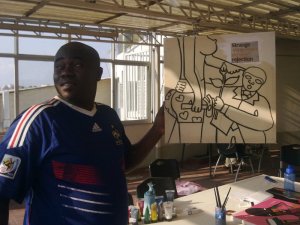
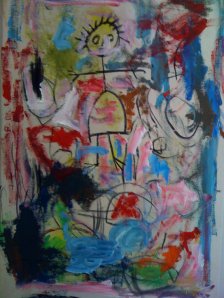

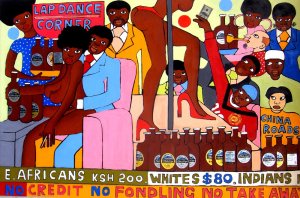
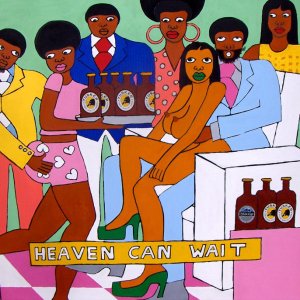
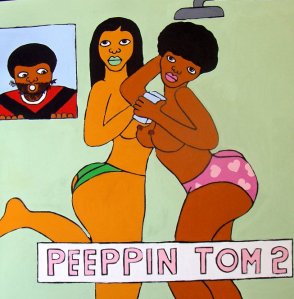
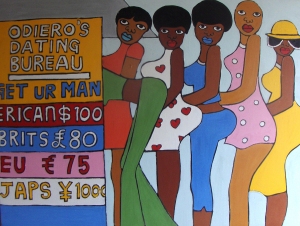

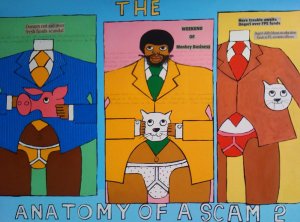
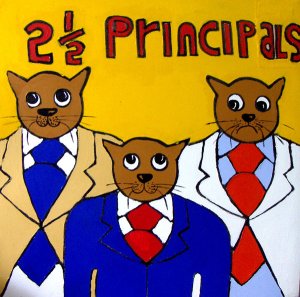
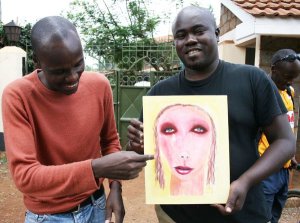
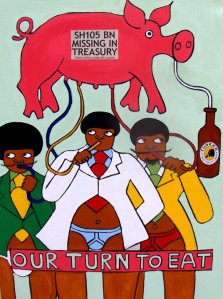
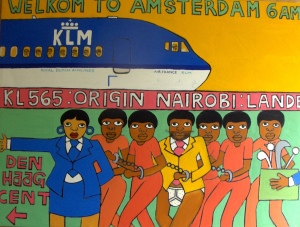
i don’t believe i told you all that but honestly, i like it and this is because i think its the most honest and accurate article ever written about me. thanks Kim.
Hey Soi, thanks for the interview and especially this view– ” i think its the most honest and accurate article ever written about me.” I feel honoured that you feel that way. This is a big compliment to me and the blog as a reference point. Thanks bro.
You are really creative you ca imagine things and make the be seen with eyes.
thank you richard
Good one Wanjiru…Michael’s work is hillarious but serious at the same time….
Good one Wanjiru…Michael’s work is hilarious but serious at the same time….
It has always been my view that reviews on art and artists should always be centered on the artist.His/her reasons behind what they do and depict,their philosophy ,life /way of living ,what influences the elements in their work etc.And for that reason I have enjoyed reading this review because it give us the insights into the depth of the artist’s being. His concern about what is happening in the country and with a young talented child ,he must be asking himself,somehow [what kind of Kenya/world] his child and others will live in?
Thanks to both of you.
Mazola Wa Mwashighadi.